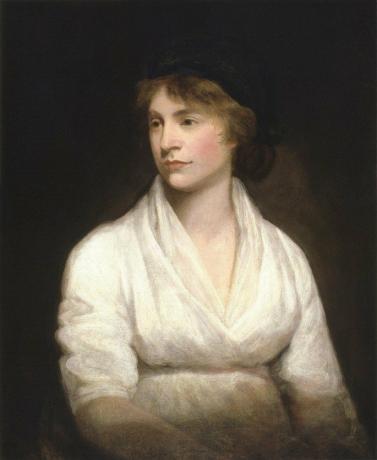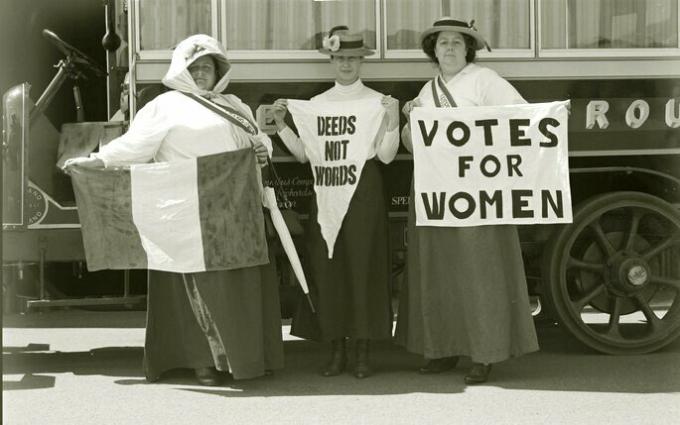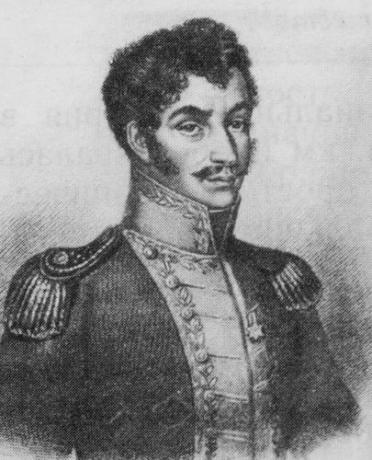The women's suffrage movement was the struggle waged by women in different parts of the world in search of right to vote.
In England, during the 19th century, the first mobilizations were highlighted, later spreading throughout the world from the 20th century onwards. This movement initiated the call first feminist wave.
The English suffragette leaders stood out Millicent Garret Fawcett and Emmeline Pankhurst, main names in the struggle for the right to vote for women, having worked in the groups National Union of Women's Suffrage Societies (NUWSS) and Women's Social and Political Union (WSPU), respectively. The female vote was approved in England in 1918 for women over 30 and in 1928 for women over 21.
In Brazil, Leolinda de Figueiredo Daltro and Bertha Lutz were the main references, fighting for the conquest that took place on February 24, 1932, with the new Electoral Code.
suffragette movement in England
In England, Mary Wollstonecraft's thinking on gender inequalities came to prominence at the end of the 18th century. In
A Vindication of the Rights of Woman (1792), the author wrote that social and political inequality between the sexes was the result of an educational process that differentiated men and women.
The change should happen with the creation of a national, universal, mixed and equal education system, which would allow women to reach the position of free citizens.
Later, the suffragette movement originated in the early 1830s and 1840s, when English women became part of libertarian movements, with such as the defense of the abolition of slavery and the Chartist movement, which sought improvements in working conditions in industries from the implementation of laws labor.
Two were the groups that had the greatest prominence in British territory, in two distinct phases: the National Union of Women's Suffrage Societies (NUWSS) and the Women's Social and Political Union (WSPU). Despite having the same claims, their fighting methods were distinguished.
In the first phase, the main English suffragette organization was the NUWSS, from the end of the 19th century, having its foundation and leadership in the figure of Millicent Garret Fawcett. The organization had a weekly newspaper, the The Common Cause (The Common Cause). His actions were based on moderation, always betting on the good will of politicians to meet his agenda.
At suffragettes
The second and also the best known phase began in 1903, in Manchester, with the foundation of the WSPU, led by Emmeline Pankhurst and her daughters Christabel and Sylvia. The group had two weekly publications, used to disseminate their ideas: votes for women (1907) and The suffragette (1912).
The term suffragettes was used to refer to these militants of the second phase. The nomenclature was created by the British press in the first decade of the 20th century, with the aim of differentiating them from the pacifist movements of the first phase. Later, the name was appropriated by the militants.
At suffragettes had as a striking feature the use of unconventional tactics to pressure the government for the suffragette cause, differentiating them from the NUWSS. The motto used by the group was Deeds not Words (Actions, not words). Therefore, marches, violence and the use of intimidation were commonplace in their acts.

WSPU activists adopted four forms of expression:
- Advertising techniques: pamphlets and publications in periodicals;
- Civil disobedience: breaking windows, interrupting speeches by politicians and setting fire to mailboxes;
- Active non-violence: peaceful demonstrations;
- Physical violence: chaining oneself to gates.
Reactions to the movement: arrests and negative press repercussions
Because of such actions, many of them ended up being arrested. Between 1911 and 1912, militant attacks led to the arrest of more than 200 women, many of them receiving sentences of up to two months in London's women's prison, Holloway Gaol.
In prison, as a form of resistance, the practice of hunger strike was common among them. The authorities then force-fed the prisoners through a feeding tube passed through the nose.
As this act of violence by the authorities became widely publicized by the militants, the British government enacted the law. The Cat and Mouse, in 1913, which allowed imprisoned women, when they became ill, to restore their health at home and then return and finish their sentence.
The WSPU members' forms of protest caused a reaction that was often contrary to public opinion, expressed mainly through the press. In newspapers, anti-suffrage ideas denigrated the movement in texts and images.
They were linked to the image of women who defended suffrage:
- Cartoons depicting militants in scenes where they were accused of abandoning their homes and families;
- Caricatures of aggressive women, without physical attributes;
- Ideas that the militants were getting involved in politics because they couldn't get a good marriage.
However, despite the negative impact that the suffragettes had in England and abroad, it is undeniable that the shift from English tactics to more violent and radical practices proved effective. The fight for the right to vote only started to be taken seriously by the British from these new actions.
Achievements of the suffragette movement
In 1914, the suffragette movement decided to put aside its struggle to support the country due to the entry of England into the First World War (1914-1918).
It was not until 1917 that a new bill was presented to the British Parliament, approved in 1918,granting the vote to women over 30 years of age.
In 1928, the British struggle for women's suffrage ended, with a new amendment, allowing women over 21 to also have the same right.
The actions of the English militants were a strong inspiration for other movements around the world. The repercussion of the acts influenced women in several countries to also join the cause, despite the resistance of many to the model incorporated by the suffragettes.
Dates when women's suffrage was implemented in some countries
1918 – England (with restrictions);
1920 – United States;
1931 – Spain;
1944 – France;
1945 – Italy;
1971 – Switzerland;
1976 – Portugal.
In Latin America
1929 – Ecuador (optional until 1967);
1932 – Brazil;
1932 – Uruguay;
1934 – Cuba;
1939 – El Salvador (optional until 1950);
1942 – Dominican Republic;
1944 – Jamaica;
1945 – Guatemala (optional until 1956);
1945 – Trinidad and Tobago
1946 – Venezuela;
1946 – Panama;
1947 – Argentina;
1948 – Suriname;
1949 – Chile;
1949 – Costa Rica;
1952 – Bolivia;
1953 – Guyana;
1954 – Honduras;
1954 – Mexico;
1955 – Peru;
1957 – Colombia;
1957 – Nicaragua;
1964 – Bahamas;
1967 – Paraguay.
The suffragette movement in Brazil
In Brazil, the 1891 Constitution stated that “citizens over the age of 21 who enlist under the law” could vote, which did not exclude women. However, even if the legislation did not veto them, they were excluded from political life by the customs of the time.
Even so, the country was one of the first to achieve this achievement in Latin America, with the publication of the Electoral Code of February 24, 1932. With it, women won the right to vote and be voted on. Two years later, in 1934, women's suffrage came to be provided for in the Federal Constitution.
The Brazilian suffragette movement is divided into two phases, with two female leaders: Leolinda de Figueiredo Daltro and Bertha Lutz, respectively.
the first phase occurred throughout the 19th century, through publications by the Brazilian women's press, debates for the inclusion of law in the first republican constitution, of 1891, and the creation of the Partido Republicano Feminino (PRF), led by Leolinda de Figueiredo Daltro.
The second This phase began with the transformation of the League for the Intellectual Emancipation of Women (LEIM) into the Brazilian Federation for Feminine Progress (FBPF), both led by Bertha Lutz. This phase ended with the conquest of the right to vote in 1932.
Background of the suffragette movement
The right to vote was a male exclusivity in many countries until the 19th century. Women were assigned a private role, while men were responsible for exercising a public life.
Political debates should not be in the woman's interest, as this would prevent her from exercising what were considered her occupations: taking care of household chores and her family.
From dissatisfaction with these conditions began the female search for the vote, initially with the participation of women from the middle and upper classes of society, who had some degree of formal education.
The struggle was part of the so-called first wave of feminism. According to studies in the area, this was marked by the claims that occurred between the end of the 19th century and early 20th century, including debates related to political, social and economic rights female.
Since the 18th century, inequality has been a topic of intense debate in Europe. The French Revolution (1789) raised discussions about the right to legal equality. It was in this context that Olympe de Gouges wrote the Declaration of the Rights of Women and Citizens (1791), advocating female participation in political life.
Because of her ideas, she was tried and sentenced to the guillotine. Despite the pioneering spirit of Gouges' ideas, women only gained the right to vote in France in 1944.
Already in the European Industrial Revolution, the inequalities between the sexes became increasingly evident: women were reserved for lower wages, lack of recognition, in addition to being victims of harassment and verbal and sexual violence in industries.
In this context, the possibility of voting was seen as a real opportunity to change their working and living conditions. According to suffragettes, the lives of women would only improve if the politicians of the time were also accountable to a female electorate.
Thus, suffrage became the main female demand, being now seen as the great key to change for the end of inequalities between men and women.
See more:
- History of Feminism in Brazil
- Women's Vote in Brazil
- Extraordinary Women Who Made History
Bibliographic references
KARAWEJCZYK, Monica. The suffragettes and the struggle for the female vote. History, 2013. Available in http://amazonaws.com/academia.edu.documents/33267419/03suffragettes.pdf. Accessed on May 31, 2022.
KARAWEJCZYK, Monica. (2016) 2021. “Sufragettes In the tropics?! The First Phase of the Suffragette Movement in Brazil”. Location: History Magazine 20 (1). https://periodicos.ufjf.br/index.php/locus/article/view/20768. Accessed on May 31, 2022

